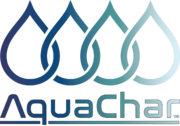When we launched AquaChar in April 2019 there was a fantastic response from the aquarium industry. Within 3 months we had landed international packaging and Distribution out of Holland with DVH-Imports and by August we were preparing for MACNA in Orlando. It was an amazing show to end the year, but the threat of Hurricane Dorian made attendance lower than expected and left up with some extra samples.
AquaChar was invented in Africa after witnessing the water needs in the capital city of Abuja in Nigeria. After MACNA we decided to pay it forward on our early successes and send the remaining samples to a partner in Nigeria. Our partner Christian, a banker, was excited and with blind faith he set out to find a specific market where AquaChar would prove to be a game changer.
Source Water in Abuja
Christian soon discovered that catfish farming was a rapidly growing industry and was considered the most economical way to product protein for the 230 million people who live in Nigeria. With little knowledge of catfish farming and enough product to start testing on a couple farms, he paid the equivalent of $5 USD to join a WhatsApp group of catfish farmers. Knowing the product would speak for itself, he set out to find farms to run AquaChar.
Here is the thing about catfish… they can lay thousands of eggs per clutch but in the wild only a few are meant to reach adulthood. Once they reach adulthood, they are hardy and can live in water that would be unhealthy for most fish. To farm catfish in bulk you need the hatchlings and fingerlings to he raised in exceptionally clean water that must be constantly changed due to the bio-load. Many farms struggle to survive because unclean water can completely wipe out an entire tank of 3-week-old hatchlings in a day.
In this WhatsApp group, AquaChar gained a lot of attention because of its long-term use and the ability to save cost on maintenance. We quickly found a small farm close to Christian who had just lost all their hatchlings because of water quality. This was an introduction on just how difficult it is to be consistently successful in this industry. Even with the lack of requested testing and consistent maintenance their yield was higher than they had ever had before.
These results sparked further interests from other farmers and put us in contact with an Israeli water & agriculture expert working on a project of raising catfish in the bush of Africa. For hatchlings he sent $50 USD per day to truck in water from the nearest town in addition to the fuel cost to run generators for pumps. He contacted us because he wanted to test our claims in the ultimate conditions.
Nachshon had developed a filtration system custom for the conditions in the bush in Africa and was interested in running AquaChar. He not only had the historical testing for his site he also knew exactly what his issues were. His first goal was to test AquaChar in a re-circulating system with hatchlings to save on the daily water costs with a long-term goal of being able to use his onsite borehole he has been unable to use (in the 6 months since drilling) primarily due to an iron level nearly three times the recommended safe level.
The recirculating system worked so well with hatchlings that weekly testing allowed for a dramatic cost savings for the reduction of imported water. Impressed by the testing results, Nachshon began working on a system using AquaChar as the primary media which would allow hatchlings using his onsite borehole water.
The first batch with the recirculation system on with the “unusable” borehole water was his highest yield ever. Additionally, as they matured, he noticed the number of “shooters” (catfish that rapidly grow 3-5x out of the fingerling stage) increased. Pleased with the results he was able to expand his operation and began to mentor Christian on proper husbandry skills.
By the summer of 2020 Christian decided that he wanted to lease and run an AquaChar catfish farm. Our first complication e-coli showed up in the borehole water due to the lack of sanitation infrastructure. After drilling a new borehole, he was able to set up a AquaChar filtration system and began hatching.
It wasn’t always easy and due to a 4 month shipping delay we developed the regeneration process to push the high use lifespan for a year… or more.
We regularly update this project on social media!
